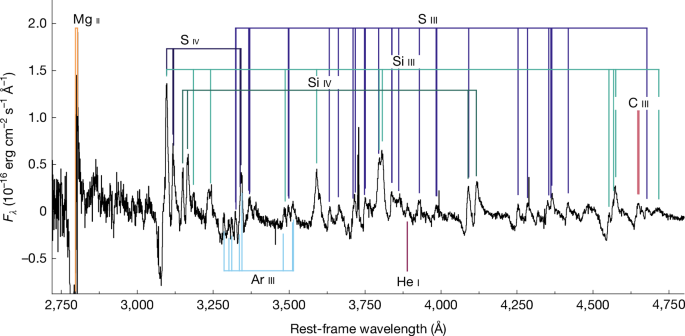Navigation
Install the app
How to install the app on iOS
Follow along with the video below to see how to install our site as a web app on your home screen.
Note: This feature may not be available in some browsers.
More options
-
Welcome to TalkWeather! We see you lurking around TalkWeather! Take the extra step and join us today to view attachments, see less ads and maybe even join the discussion. CLICK TO JOIN TALKWEATHER
You are using an out of date browser. It may not display this or other websites correctly.
You should upgrade or use an alternative browser.
You should upgrade or use an alternative browser.
New type of supernova reported
- Thread starter Central Ohio Wx
- Start date
KakashiHatake2000
Member
oh wow thats soo cool ohioan very neat and interesting discovery by nasa too

Introducing a new supernova classification type: SN Ien
Following the discovery and classification of SN 2021yfj whose unique early spectra are completely dominated by prominent emission lines of highly ionized silicon, sulphur and argon, lacking prominent features from carbon, oxygen, helium and hydrogen, we propose to tentatively introduce a new...
Found the paper - took a second. A surface-level look reveals this is a supernova dominated in its spectra by argon, sulfur, and ionized silicon. The funkiest part is that it lacks the typical type I/II supernova spectrum containing strong hydrogen, carbon, helium, oxygen, etc.
Definitely very odd and interesting indeed! It suggests that the inner layers of the progenitor star are being expelled, at the very least, before the outer layers are, which is super odd and we have no idea what that could entail. There’s probably some incredibly violent and unknown mass loss mechanism occurring here according to this paper:

Extremely stripped supernova reveals a silicon and sulfur formation site - Nature
Observations of SN 2021yfj reveal that its progenitor is a massive star stripped down to its O/Si/S core, which remarkably continued to expel vast quantities of silicon-, sulfur-, and argon-rich material before the explosion, informing us that current theories for how stars evolve are too narrow.
I will say though, there’s not a lot I can interact with here outside of just the reporting of this odd observation. I can’t seem to find a full pdf for the first paper I listed in this post. When I get to my computer, I’ll take a closer look.
EDIT: I wouldn’t be surprised in the slightest if such a supernova involved a Wolf-Rayet star of some kind (I can explain what these are in a separate post, but tldr for now) but it would likely have to require a new type of WR star, if that’s the case. This is pure conjecture by me, and shouldn’t be taken as the truth, however.
Also, I will say, the "defied textbooks" part is a little bit hype-ish by whichever outlet stated that. While it's true we don't have any idea how such a supernova could happen currently, it doesn't mean that our ideas of the physics going on within supernovae are wrong. It likely means some tweaks to our ideas simply need to be made, and whatever mechanism was responsible for such a violent explosion is likely to be an extraordinarily rare event that probably does not involve typical supernova processes, like core-collapse, type Ia, pair production, etc.
KakashiHatake2000
Member
i sort of wish we could have a fishing rod with a tool attached to it so we could study this supernova it would have to be a long fishing rod and i dont know about any of the other things that could happen with the tool breaking off stuff like that but yeah agreed slenker i hope more research could come out of this and other space and universe phenomenon and discoveries

